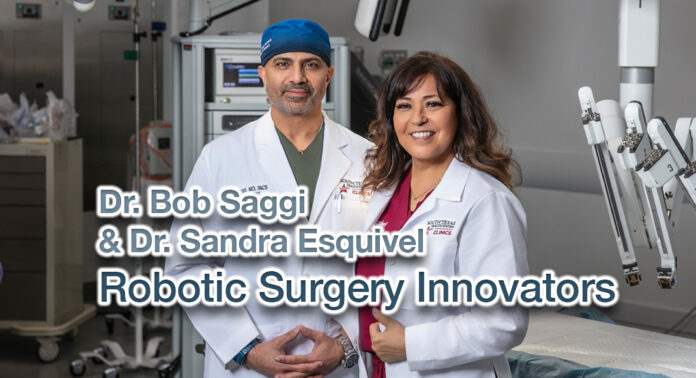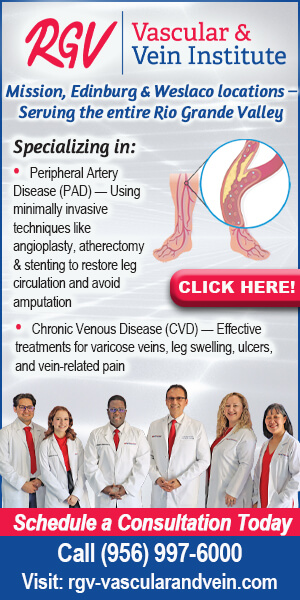Mega Doctor News
A pioneering innovation in the medical industry, robotic surgery has helped redefine the landscape of surgical procedures by combining robotic precision with a surgeon’s skill and expertise.
In March 2025, STHS Edinburg leaders and operating room staff celebrated Bob Saggi, MD, FACS, for completing 1,500 robotic procedures at the facility. By March 28, that number had climbed to 1,551. Meanwhile, Sandra Esquivel, MD, FACS who celebrated her 1,000th robotic procedure in May 2023, has now performed 1,648 robot-assisted surgeries at the facility as of March 28.
The dedication shown by these two surgeons was a major contributor to another milestone, this one for the facility, as South Texas Health System® Edinburg was on pace to reach 4,000 robotic surgery cases in April 2025, a decade after launching the facility’s robotic surgery program.
Both physicians were awarded the Surgeon of Excellence designation by the Surgical Review Corporation (SRC), a non-profit patient safety organization, in 2021. This recognition came as STHS Edinburg, which had already been nationally recognized for its robotic and minimally invasive surgery programs, received its accreditation as a Center for Excellence in Hernia Surgery by the Surgical Review Corporation. STHS Edinburg also is an accredited Center of Excellence for minimally invasive and robotic surgery.
Spotlight on Dr. Saggi
Dr. Saggi is a Diplomate of the American Board of Surgery and a Fellow of the American College of Surgeons. He earned his medical degree from the University of Kentucky College of Medicine in Lexington, and completed his training at the Medical College of Virginia in Richmond and the David Geffen School of Medicine at the University of California at Los Angeles.
His specialties include complex hernia repair, dialysis access for kidney failure, single incision gallbladder surgery, surgery for gastrointestinal and breast cancer, and surgery of the liver, pancreas and bile duct.
How does Dr. Saggi feel about completing his 1,500th robotic procedure? “It’s an amazing milestone for me as a surgeon, as well as for STHS Edinburg, because it demonstrates our combined dedication to consistently delivering positive patient outcomes,” he says. “While this is a feat to be celebrated, we’re committed to continue to grow our volumes and expand the scope of the procedures performed to provide Rio Grande Valley patients requiring surgery with better results and speedier recovery times.”
Spotlight on Dr. Esquivel
Dr. Esquivel is a Diplomate of the American Board of Surgery and a Fellow of the American College of Surgeons. She attended medical school at the University of Texas Southwestern Medical Center in Dallas and completed her general surgery residency in the same city at Parkland Memorial Hospital.
Her surgical specialties include breast abnormalities, including breast cancer; gallbladder stones; hernias; diverticulitis/colon surgery; and a variety of other surgical conditions.
Speaking on the importance of the robotic program at Edinburg, Dr. Esquivel says, “Laparoscopic surgery was a stepping-stone to get to this point, but surgeons are still somewhat limited as far as some of the things we can do with laparoscopic surgery. From a medical standpoint, we always want to improve things. To me, [robotic surgery] is a natural progression towards making things better for the patient.”
The Robotic Surgery Difference
In 2015, STHS Edinburg became the first medical facility south of San Antonio to use the da Vinci Xi® system and later acquired its second da Vinci Xi in February 2021.
The da Vinci system gives surgeons a greater range of motion and dexterity, making it easier to manipulatetissue. In addition, surgeons are able to see a highly magnified, high-resolution image of the operating field, giving them better visualization and allowing for more precise surgery.
Overall, it makes the entire surgical process a little bit easier, not just for the surgeon but also for the patient.
Benefits for Surgeons
That’s because robotic procedures allow surgeons to operate on a patient through one or more small incisions which are typically less than or equal to one centimeter long.
Instead of relying on handheld instruments and a separate video monitor, robotic systems enable surgeons to control four steady robotic arms through a video guidance system. When using a robotic system, surgeons sit at a console in the operating suite with a video monitor that displays the surgical area.
After the surgical arms are placed in the correct position, surgeons control them from the console to complete the procedure. The da Vinci Xi system uses smaller, lighter arms that have an extended range of motion compared to previous systems, and bending and rotation capabilities that far exceed the human hand.
The system uses laser-guided targeting to pinpoint the surgical area, and then configures itself into the optimum position for the procedure. A magnified 3D HD vision system provides surgeons with clear vision and true depth perception.
Benefits for Patients
This minimally invasive method can improve patients’ overall hospital experience by reducing the amount of recovery time and reducing pain. The less invasive procedures have also helped decrease the risk of infection because of the smaller incisions.
For example, Dr. Esquivel’s 1,000th robotic procedure was a on a patient requiring a colostomy takedown (surgery to reconnect the colon following a colostomy). In contrast to traditional surgery for this procedure, which may involve an abdominal incision as long as 12 inches, this minimally invasive method requires much smaller incisions.
“There’s less damage to the body than with open surgery. I’ve seen my patients experience much less pain than those who had traditional surgery, and their recovery time has been that much quicker. Many of these minimally invasive procedures require a shorter hospital stay or are done as outpatient procedures, which allows our patients to get back to their daily lives,” Esquivel says. “I first started doing them on some of my older patients and I was so impressed by how little pain they reported experiencing and how quickly they were able to go back to doing their regular activities.”
Our Commitment to Improving the Surgical Experience
For 10 years, South Texas Health System Edinburg has provided advanced surgical solutions to improve patient outcomes, including minimally invasive procedures that help shorten hospital stays, improve recovery times and minimize risks.
“The addition of the robotic surgery program at STHS Edinburg has had a tremendous impact on the community, providing nearly 4,000 patients with advanced technology that allows them to get back to normal much quicker compared to traditional surgery,” says Lance Ames, Chief Executive Officer, STHS Edinburg & STHS Children’s. “It’s an important way that STHS Edinburg is making a difference in the lives of Valley residents.”
Learn more at southtexashealthsystemedinburg.com/robotic
Individual results may vary. There are risks associated with any surgical procedure. Talk with your doctor about these risks to find out if robotic surgery is right for you. Physicians are independent practitioners who, with limited exceptions, are not employees or agents of South Texas Health System. The System shall not be liable for actions or treatments provided by physicians. For language assistance, disability accommodations and the nondiscrimination notice, visit our website.
See related story:












